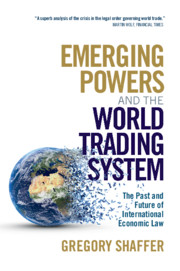Book contents
- Reviews
- Emerging Powers and the World Trading System
- Emerging Powers and the World Trading System
- Copyright page
- Dedication
- Contents
- Figures
- Tables
- Preface: The Project and Its Methodology
- Part I Legal Capacity and Transnational Legal Orders
- Part II The Cases of Brazil, India, and China
- 4 Building Legal Capacity and Adapting State Institutions in Brazil
- 5 India: An Emerging Giant’s Transformation and Its Implications
- 6 How China Took on the United States and Europe at the WTO
- 7 A New Chinese Economic Law Order?
- Part III The Future of the Transnational Legal Order for Trade
- Acknowledgments
- Abbreviations
6 - How China Took on the United States and Europe at the WTO
from Part II - The Cases of Brazil, India, and China
Published online by Cambridge University Press: 23 July 2021
- Reviews
- Emerging Powers and the World Trading System
- Emerging Powers and the World Trading System
- Copyright page
- Dedication
- Contents
- Figures
- Tables
- Preface: The Project and Its Methodology
- Part I Legal Capacity and Transnational Legal Orders
- Part II The Cases of Brazil, India, and China
- 4 Building Legal Capacity and Adapting State Institutions in Brazil
- 5 India: An Emerging Giant’s Transformation and Its Implications
- 6 How China Took on the United States and Europe at the WTO
- 7 A New Chinese Economic Law Order?
- Part III The Future of the Transnational Legal Order for Trade
- Acknowledgments
- Abbreviations
Summary
In joining the World Trade Organization in December 2001, China assumed vast legal commitments that significantly affected its internal laws and institutions. Western countries hoped to transform China and integrate it into a liberal, capitalist global economy.1 Many of China’s leaders aimed to use the process for internal reform as well. Nonetheless, they wished to do so on their own terms, and they faced considerable opposition internally. The government invested massively in developing legal capacity, including to adjust to WTO requirements that the United States had pressed upon it. In the process, China learned how to defend its interests through the WTO and to use the rules against the United States and the European Union. China’s responses affected US and European perceptions of the legal order, and the US reaction, in turn, has eroded it. As China grew economically and benefited from liberalized trade, as the 2008 financial crisis humbled American-style neoliberalism and raised China’s profile, and as President Xi assumed power and favored a growing role for the state and state-owned enterprises, what had seemed a tough deal for China in its WTO Accession Protocol increasingly appeared to many in the United States to be unfair to the United States.
- Type
- Chapter
- Information
- Emerging Powers and the World Trading SystemThe Past and Future of International Economic Law, pp. 174 - 221Publisher: Cambridge University PressPrint publication year: 2021
- 2
- Cited by



